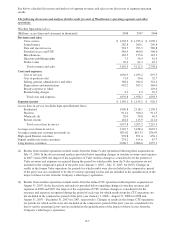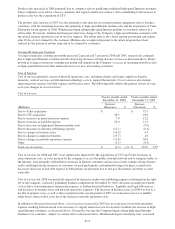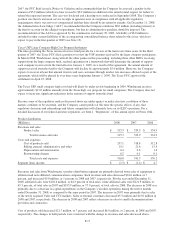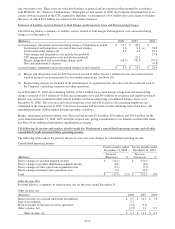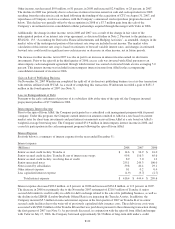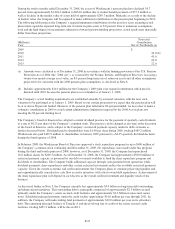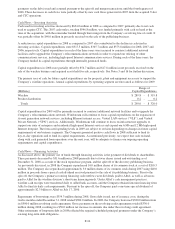Windstream 2008 Annual Report Download - page 104
Download and view the complete annual report
Please find page 104 of the 2008 Windstream annual report below. You can navigate through the pages in the report by either clicking on the pages listed below, or by using the keyword search tool below to find specific information within the annual report.
The legislation allocates approximately $7.2 billion for the expansion of both wired and wireless broadband services.
However, many of the details for implementing the expansion programs will be determined by the government
agencies charged with their oversight. Until that process occurs, we cannot determine whether or not, or to what extent,
the Company would benefit from the broadband service component of the legislation.
Price-Cap Petition Granted by FCC
Effective July 1, 2008, the Company converted the majority of its remaining interstate rate-of-return regulated
operations to price-cap regulation. Price-cap regulation better aligns the Company’s continued efforts to improve its
cost structure, because rates for interstate wholesale services are not required to be periodically adjusted based on the
Company’s cost structure, and under price-cap regulation, high-speed Internet services can be deregulated. As
previously discussed, high speed Internet services were deregulated effective July 1, 2008. Prior to the conversion, with
the exception of our Nebraska and New Mexico operations, and a portion of our Kentucky, Oklahoma and Texas
operations, our interstate ILEC operations were subject to rate-of-return regulation by the FCC.
Inter-carrier Compensation
On November 5, 2008, the FCC released an order affirming a prior decision regarding compensation payable to local
exchange companies for the termination of dial-up Internet Service Provider bound traffic. Also on this date, the FCC
issued a further notice of proposed rulemaking (“FNPRM”) that sought comment on proposals that would change the
rules governing inter-carrier compensation. Proposals considered by the FNPRM would significantly reduce inter-
carrier compensation revenues over a ten year period, classify voice-over-Internet protocol (“VoIP”)/public switch
telephone network (“PSTN”) traffic as “information service”, and adopt measures to ensure proper billing of “phantom
traffic.” Windstream strongly supports regulatory reform, but is opposed to the draft order as originally proposed by
the FCC. We have submitted an alternative proposal that includes a reduction in access rates and increases in
subscriber line charges to our customers and a modest increase in universal service support. At this time, we can not
predict the ultimate outcome of these proceedings or the impact on our revenues and expenses.
The following table reflects the minute-driven components of Windstream’s inter-carrier compensation revenues for
the year ended December 31, 2008:
Revenues
Originating Traffic Terminating Traffic
Minutes Rate Minutes Rate
(Thousands) (Thousands)
Interstate switched access 3,774,024 $0.0070 3,401,296 $0.0070
Intrastate switched access 2,474,898 $0.0340 2,614,802 $0.0430
Local interconnection - - 5,407,034 $0.0089
In addition, inter-carrier and reciprocal compensation expense totaled $134.1 million in 2008.
State Regulation
Local and Intrastate Rate Regulation
Most states in which our ILEC subsidiaries operate provide alternatives to rate-of-return regulation for local and
intrastate services. We have elected alternative regulation for our ILEC subsidiaries in all states except New York. On
March 4, 2008, the New York PSC issued an order providing rate flexibility to certain rate-of-return regulated carriers,
like Windstream, based on the level of competition in their service areas and whose regulated earnings are no higher
than five percent above their authorized threshold. We continue to advocate for greater alternative regulation options in
New York where our ILEC subsidiary remains subject to rate-of-return regulation.
State Universal Service
We recognize revenue from state universal service funds in a limited number of states in which we operate. During
2008, Windstream received $140.1 million in state universal service support, which included approximately $103.2
million from the Texas USF. These payments are intended to provide additional support, beyond the federal universal
service receipts, for the high cost of operating in rural markets.
During the third quarter of 2007, the staff of a state Public Utility Commission (“PUC”) notified the Company that the
PUC Staff believed the Company had been over-compensated from its state universal service fund dating back to 2000
by the amount of $6.1 million plus interest in the amount of $1.2 million (for a total $7.3 million). On October 18,
F-16



